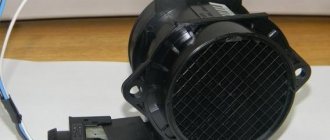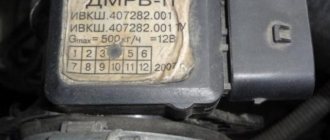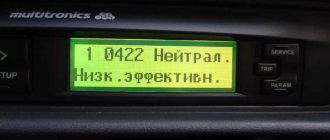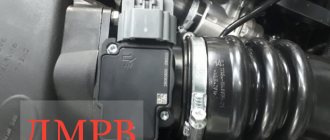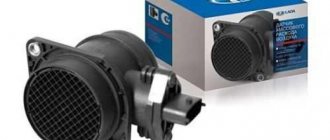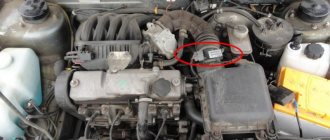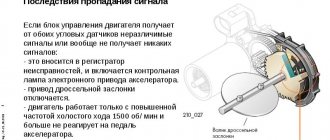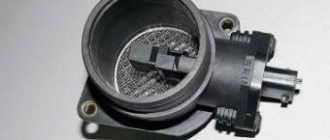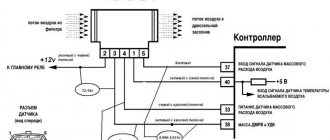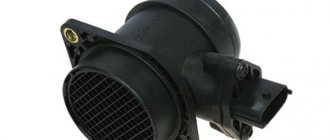03.03.2022 34 225 Sensors
Author: Ivan Baranov
The Bosch 116 mass air flow sensor or mass air flow sensor is a regulator designed to control the volume of air that enters the engine. This controller is one of the elements of electronic engine control systems with fuel injection. In this article we will try to answer the question of how models 116 and 037 differ.
[Hide]
Three signs that will help distinguish the original Bosch mass air flow sensor
October 02, 2022 Category: Useful information.
We have already written about the KeySecure System from Bosch, which allows you to verify the authenticity of purchased products.
Today we’ll talk about how else you can distinguish a Bosch mass air flow sensor (MAF) from a fake.
There are two types of BOSCH mass air flow sensors on the market, with serial numbers 0 280 218 037 and 0 280 218 116
- made in Germany are supplied in “oiled” paper and a soft cardboard box, on the product body there is a factory code, 816.
- The air flow sensors assembled in Russia from German components are packaged in a plastic bag with a lock and a porous cardboard box, factory code 599.
Ignition coils
On the original Bosch ignition coils, the quality of the drawings is more accurate and clearer. On the fake, all the drawings are shown with dotted lines - ordinary strokes.
The inscriptions on the packages are identical, the stickers are also identical.
Let's see what's inside. Even at first glance, a fake reel looks just like Chinese trash - it does not match the quality of BOSCH. The stickers are green everywhere. On the original it is darker, on the fake it is lighter.
If you look closely, the contacts to which the high-voltage wires are connected are all crooked, that is, one looks to the left, the other to the right.
The metal color of the contacts inside is yellow, on the original it is white. Made carefully.
Friends, don’t give counterfeit manufacturers a chance, don’t buy fakes. Be careful, don't be fooled.
What is the difference between sensors 037 and 116?
How can the regulators of these models differ from each other and is it possible to install 116 instead of 037? There are differences between these controllers, and the point is not in the MAF pinout. After all, if these models were the same, what would be the point of giving them different names?
So, how do the controllers differ from each other and is it possible to install model 116 instead of 037:
- The first difference that can be guessed based on the technical characteristics is that the 037 model can produce data with an error during operation. Of course, an error of 2.5% is not critical, but it does exist.
- Device 037 is intended for installation in VAZ 2111, 2112, 2123, 21214 cars, which are equipped with controllers M 1.5.4, January 5.1-5.1.3, etc.
- As for model 116, its use is relevant on Ladas 21114, 21124, 21214. Installation of this device is allowed on Kalina and Priora. Installation of the device is allowed on cars equipped with M 7.9.7 and January 7.2 controllers.
If you encounter a problem with the device not working, then when replacing it you need to install the same model that has already been installed. But it is worth considering that 037 is not a common option like 116, so it is more difficult to find. The latter, in turn, is more common, and its cost is lower.
Replacement is allowed, but experts do not recommend this. This is because these devices differ in their calibration, so in case of replacement, you will have to change the parameters of the control unit. And you can only get into the “brains” of a car if you understand what needs to be done and have minimal experience.
Mass air flow sensor table. VAZ DMRV engines. Last three digits
But to implement them, it is necessary that the sensors informing the controller do not deceive it - only under this condition do the processes in the cylinders proceed normally, the engine develops sufficient power without consuming excess fuel and without causing much harm to the environment. One of these sensors measures the amount of air entering the cylinders and generates a corresponding signal to the controller. This can be an absolute pressure sensor (MAP sensor) or a mass air flow sensor (MAF). We see the latter on many cars, including VAZ ones.
The first was the frequency mass air flow sensor of the GM control system. It was also used in the domestic analogue “January” of the 4th series (photo 1). Cars of this configuration did not last long on the assembly line - the frequency sensor was replaced by an analog model HFM-5 from Bosch - its number is 0280218004 (photo 2). It is not interchangeable with GM - the connectors and mounting points are different. The German sensor is dismountable, consisting of two parts - a housing and a measuring element.
The latter is secured in the case with two screws with “secret” heads. True, nowadays you can buy the necessary tools in auto parts stores. The measuring element is a compact thing, but it is expensive - in Moscow from 1300 rubles. and higher. Having removed this part from a new car, in exchange, of course, they will put a dummy, and everything that follows is the “personal grief” of the car buyer. The market is full of such “mass air flow sensors without a housing”... It is unwise to buy a measuring element without a housing: it is very possible that it is faulty or the wrong model. Bosch only sells assembled sensors in traditional yellow cardboard packaging. Let us remind you that the store may not accept a return air flow sensor purchased from the “wrong system” if the motorist does not provide a certificate from the service, and it is often difficult to obtain one. An unnecessary expensive unit will remain as a keepsake.
The third version of the mass air flow sensor is 037. (Here we are talking about the last three digits in the designation.) This is a further development of the 004th sensor from Bosch. Such a sensor is used today on most VAZ cars traveling on the roads, including Niva and Chevrolet Niva. Externally, 004 and 037 are almost indistinguishable - just look at the number (photo 3). Recently, additional markings have appeared on products: now there are numbers on both the body and the measuring element - they must match. The main difference is inside the mass air flow sensor. In photo 4 on the right is the 037th sensor. It has a different design of the measuring element, with a characteristic cutout (when purchasing, it makes sense to remove the plug and look inside).
But now a new control system has appeared - Bosch-M7.9.7, which has its own, 116th, mass air flow sensor. It is not interchangeable with the previous ones, although its body is the same. To avoid confusion, a green circle was initially applied to the body (photo 5). There are numbers on both the body and the measuring element (photo 6). The latter determines the purpose of this mass air flow sensor - the design has been changed again (photo 7). To prevent elements from being replaced on the way from the factory to the consumer, the kind German designers installed other secret screws. Eh, naive! The required tool is already sold on the Russian market. Carefully inspect the mass air flow sensor: when unscrewing the secret screws, their coating is usually damaged. If you notice, draw your own conclusions!
The table will help you simplify your choice when buying a mass air flow sensor.
Description
The mass air flow sensor (MAF) is located near the air filter to determine the amount of flow passing through the air filter. When a sensor fails, the controller usually generates an error, but if the sensor simply does not meet its original characteristics, this can affect the power characteristics of the machine.
How to check
You can check the serviceability of the sensor as follows: - If you notice that the car has begun to accelerate sluggishly and there is a suspicion of a mass air flow sensor, then you can check this in a simple way. 1. Disconnect the sensor connector. 2. Start the engine. 3. Engine speed should become more than 1500. Try to drive. If you feel that the car has become “faster”, then this indicates a malfunction of the mass air flow sensor; it should be replaced with a new one.
Differences between different versions of mass air flow sensors
There are 3 modifications of air flow sensors: 004, 037, 116. 004 was placed under the Rossiya 82 toxicity standards. 037 was installed on an ECU with a resonant DD and “Russia 83” or “Euro-1” standards. The 116 version was installed on Euro-1 and Euro-2 cars. The latest version of the MAF 116 has a built-in air temperature sensor. Therefore, sensors 004 and 037 (they do not have a temperature sensor) can be replaced with 116, but not vice versa.
Different versions of sensors differ slightly in calibrations. If you install a different version of the sensor (for example, 116 instead of 037), then you need to adjust its calibrations in the controller firmware.
Calibrations of versions 037 and 116 DMRV
Below are instructions for replacing the sensor.
The Bosch 116 mass air flow sensor or mass air flow sensor is a regulator designed to control the volume of air that enters the engine. This controller is one of the elements of electronic engine control systems with fuel injection. In this article we will try to answer the question of how models 116 and 037 differ.
Determining when to replace
A new flow meter is installed only after the old one breaks down. Sometimes it is “reanimated” by thorough purging, but even in this case the device will not work long enough.
The main reasons for replacement are dirt and time. If in the case of time everything is relatively clear (heating elements cannot last forever), then contamination occurs for several reasons. The most common is the inability of the air filter to cope with its tasks. If such a filter fails, the driver has a couple of thousand kilometers left - after that the quality of the engine will drop significantly. Also, the poor condition of the wiring hurts the flow meter.
Monitor the condition of the engine. Oil vapors entering the air duct accelerate wear of the air flow sensor. The causes of oil vapors are wear of valve seals and piston rings.
Causes of malfunctions
In 90% of cases, this is contamination of sensitive sensors.
- a low-quality (not certified) or incorrectly installed air filter allows dust to enter the mass air flow sensor measuring channel;
- when operating the vehicle in wet weather or driving through puddles, droplets of water may enter the intake manifold;
- If the crankcase ventilation system does not work (damaged hoses, broken valve), drops of oil enter the air duct pipe.
How to check the mass air flow sensor (MAF)
- Check Engine light comes on,
- vehicle fuel consumption increases,
- it is difficult to start the engine “hot”,
- dynamics disappeared, acceleration became slower,
- The engine power dropped noticeably.
There are several basic ways to check the operation of the mass air flow sensor (MAF).
What happens if the mass air flow sensor is faulty
The ECU controller will stop receiving or receive distorted air mass data, resulting in the fuel-air mixture being formed incorrectly. The result is a loss of power and torque (in VAZ cars these parameters are not too high anyway), as well as an increase in fuel consumption.
Signs of a malfunction of the mass air flow sensor - absence or incorrect value of the information signal from contact No. 5 of the sensor connector. If the sensors break down, an overestimation of indicators is first observed (up to 25%), then a complete cessation of information output. This leads to the following symptoms:
- on a cold internal combustion engine, the speed is increased by at least a third;
- with a sharp release of gas, the speed first remains at the same level, then slowly decreases;
- fuel consumption increases significantly;
- the car may stall immediately after starting;
- lacks acceleration dynamics and traction under load.
How to check the MAF sensor on a VAZ
The most reliable way is to use a diagnostic scanner (at least at the ELM-327 level). We connect to the OBD port and look at the flow meter performance indicators on the computer.
If you don’t have a scanner, you can take the basic parameters with a multimeter. To diagnose and repair the VAZ 2114 mass air flow sensor with your own hands, you need to know the pinout of the contacts.
For example, consider a contact block for a VAZ 2114: a modern 8 or 16 valve engine, BOSCH mass air flow sensor (or its equivalent) version 116.
- We don't need contact No. 1; this is an air temperature sensor.
- Contact No. 2 - 12 volt power supply. If the on-board voltage regulator malfunctions, the air flow sensor may malfunction.
- Contact No. 3 - ground.
- Contact No. 4 - power supply for the mass air flow sensor electronics, an important parameter, the voltage must be stable.
- Contact No. 5 is the same “floating” voltage with which the ECU calculates the volume of air passing through the intake manifold.
The supply voltage is checked with the block disconnected. We turn the ignition key, but do not start the engine. With respect to ground, we measure the voltage at contact No. 2 (12 volts) and contact No. 4 (5 volts). This indicates the serviceability of the ECU and the integrity of the wires and contacts.
Checking the signal voltage on pin No. 5 is carried out with the connector connected, with the ignition on (do not start the engine!).
- voltage is within 0.99-1.02 volts - the sensor is working;
- voltage within 1.03-1.05 volts - replacement will be required soon;
- more than 1.05 volts - the mass air flow sensor does not operate normally.
mass air flow sensor
Post by DW-ASP » April 26, 2012, 2:28 pm
Re: mass air flow sensor
Post by andry59 » 01 May 2012, 18:50
Re: mass air flow sensor
Post by DW-ASP » 02 May 2012, 12:38
Characteristic
On VAZ cars, the mass air flow sensor is mounted between the air filter element and the throttle hose. Today, products from the manufacturer Bosch are very popular among compatriots. Regardless of whether it is a universal Bosch sensor or, for example, spark plugs, quality from a German manufacturer can always give a head start to domestic products. Let's look at the main characteristics of regulators models 116 and 037.
116
DMRV 116 is designed to control and convert the air flow that enters the motor into voltage. The data transmitted by the regulator makes it possible to determine the operating mode of the power unit and calculate the cyclic filling of the cylinders with air flow. This filling is carried out in steady-state operating modes of the motor, which last no more than 0.1 seconds.
Let's look at the technical features that Bosch 0 280 218 116 has:
- the regulator operates on the principle of measuring air flow;
- the device provides accurate data, which ensures optimal fuel consumption;
- operating range varies from 8 to 550 kg/h;
- the output pulse level when measuring the range from 0 to 100% will be about 0.05-5 volts;
- As for power supply, the controller is powered from the vehicle’s electrical network, that is, 12 volts is enough for it;
- current consumption is about 0.5 ampere;
- the regulator can function normally in the operating range from 45 degrees below zero to 120 degrees;
- The service life of the Bosch 116 mass air flow sensor is about 3 thousand hours.
Bosch 116 device
037
As for the mass air flow sensor 037 from Bosch, the technical features will be similar. The controller consists of two main elements - working and control, as well as a heating resistor device. The air that enters the engine cools one of the controllers, while the electronic module converts the temperature differences between the controllers. In the event that sensor 280 218 037 fails, its options will be performed by TPS.
As mentioned above, the technical features of the models are the same:
- the operating range for normal operation varies in the region of 8-550 kg/h;
- when operating correctly, the controller will provide accurate data, making it possible to achieve optimal gas mileage (of course, if the engine is running in normal mode);
- since the element is used in a car, it is logical that it should be powered by 12 volts;
- the controller consumes about 0.5 ampere of current;
- the part can operate normally both at 45 degrees below zero and at 120 degrees of heat, this is its operating range;
- service life is at least 3 thousand hours;
- unlike model 116, the new mass air flow sensor 037 during calculations can produce an error of 2.5 percent (both downward and upward).
Regulator model 0280218037
What is a mass air flow sensor, why is it important and how to diagnose its malfunction
Over the past three decades, engines with distributed and direct fuel injection have finally supplanted all other types of designs. It would seem that this is a considerable period of time, but engineers have not been able to overcome the “childhood diseases” of important electronic components, including the mass air flow sensor (MAF), which is responsible for the composition of the air-fuel mixture. Let's remember how the mass air flow sensor works, why it is so important and how to diagnose its malfunction.
What is DMRV
Modern engines use two types of power supply systems: with distributed injection, the nozzle supplies fuel to the intake pipe, with direct injection, it supplies fuel to the combustion chamber. For both systems, the correct operation of the mass air flow sensor, which was once mechanical (vane type), but is now devoid of moving mechanical parts and made hot-wire (from “anemo” - wind), is important.
Factory air flow sensor made in Germany for a VAZ engine
The mass air flow sensor can be installed not only on a gasoline engine, but also on a diesel engine, where the operation of the EGR valve (exhaust gas recirculation system) is “tied” to it.
As old-school drivers used to say, an internal combustion engine does not work in two cases: there is nothing to burn or there is nothing to set it on fire. The mass air flow sensor precisely informs the electronic control unit about the amount of incoming air, the oxygen of which becomes the “fuel” for the working mixture. Having received such a signal, the ECU can ensure the most complete combustion possible. The device, located in the intake tract, consists of two resistors, which can be designed in various designs. In the first case, the resistor is exposed to passing air: when the flow intensity changes, it cools and its internal resistance changes. In the second case, it is not blown - based on the difference in readings from two resistors, the volume of air that needs to be supplied to the cylinders is calculated.
The sensor is supplied to the aftermarket with protective caps to prevent contamination during transportation.
This is what the sensor looks like on a regular VAZ engine. It will not be possible to remove it from the case without a special key.
The removed sensor is in its “bare” state. The sensitive element is clearly visible
Based on the data on the mass and temperature of the incoming air, the ECU determines its density, and also calculates the duration of opening of the injectors and the amount of fuel supplied to the combustion chamber. In general, the mass air flow sensor is important for achieving maximum engine power, for more complete combustion (environmentally friendly), and for economical driving. The failure of this sensor, like most others, causes the Check Engine warning light to go off.
The check engine light can come on for any reason. If there is no on-board computer with a diagnostic function, you will have to go to a service station where there is a scanner
However, the owner does not always associate the triggered “check” with the mass air flow sensor - especially if the engine runs without any interruptions, and the dynamic characteristics of the car have not deteriorated at all. Therefore, it is important not to leave the illuminated engine malfunction indicator unattended, but to consider errors with the diagnostic computer.
Replacing the sensor - instructions
Using a screwdriver, unscrew the clamp of the air intake corrugation at the sensor outlet, pull it off and carefully inspect the internal surfaces of the sensor itself and the corrugation. These surfaces must be dry and clean; traces of condensation and oil are unacceptable. If the air filter is changed rarely, then dirt getting on the sensitive element of the sensor is the most common cause of its breakdown in VAZ cars.
There may be oil in the mass air flow sensor as a result of an increased oil level in the engine crankcase, or the oil sump of the crankcase ventilation system is clogged.
Next, unscrew the 2 screws of the sensor with a 10mm wrench and remove it from the air filter housing. There should be a rubber sealing ring on its front part (at the entrance edge). It prevents unfiltered air from being sucked into the intake tract through the sensor.
